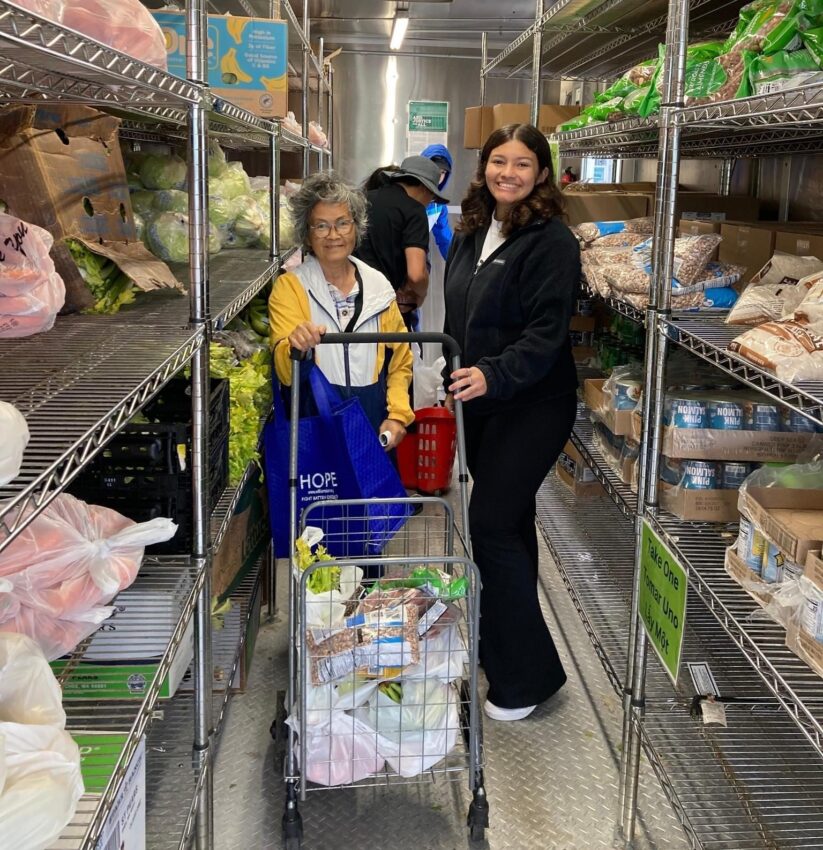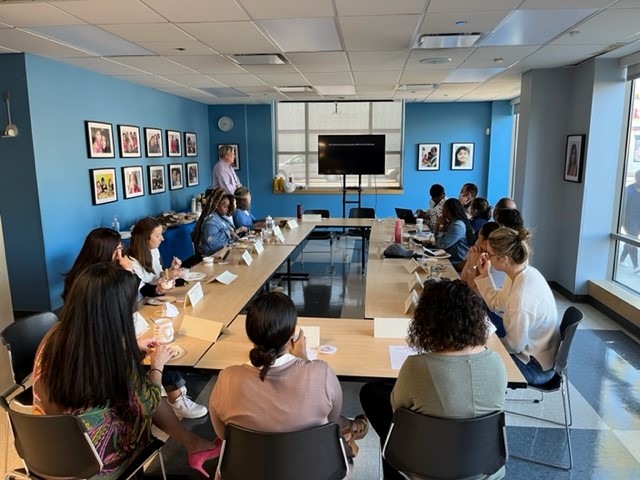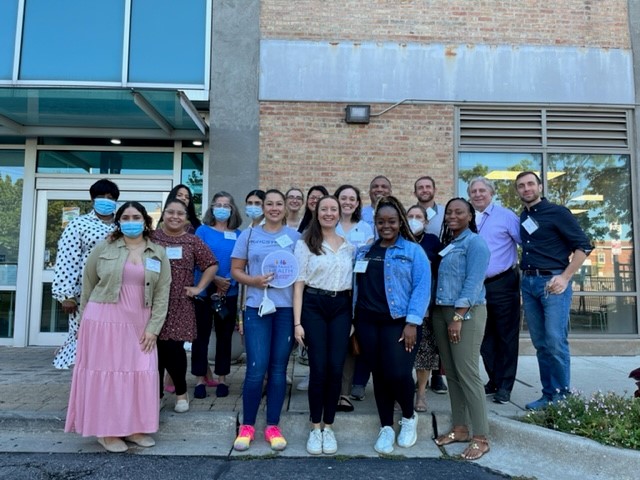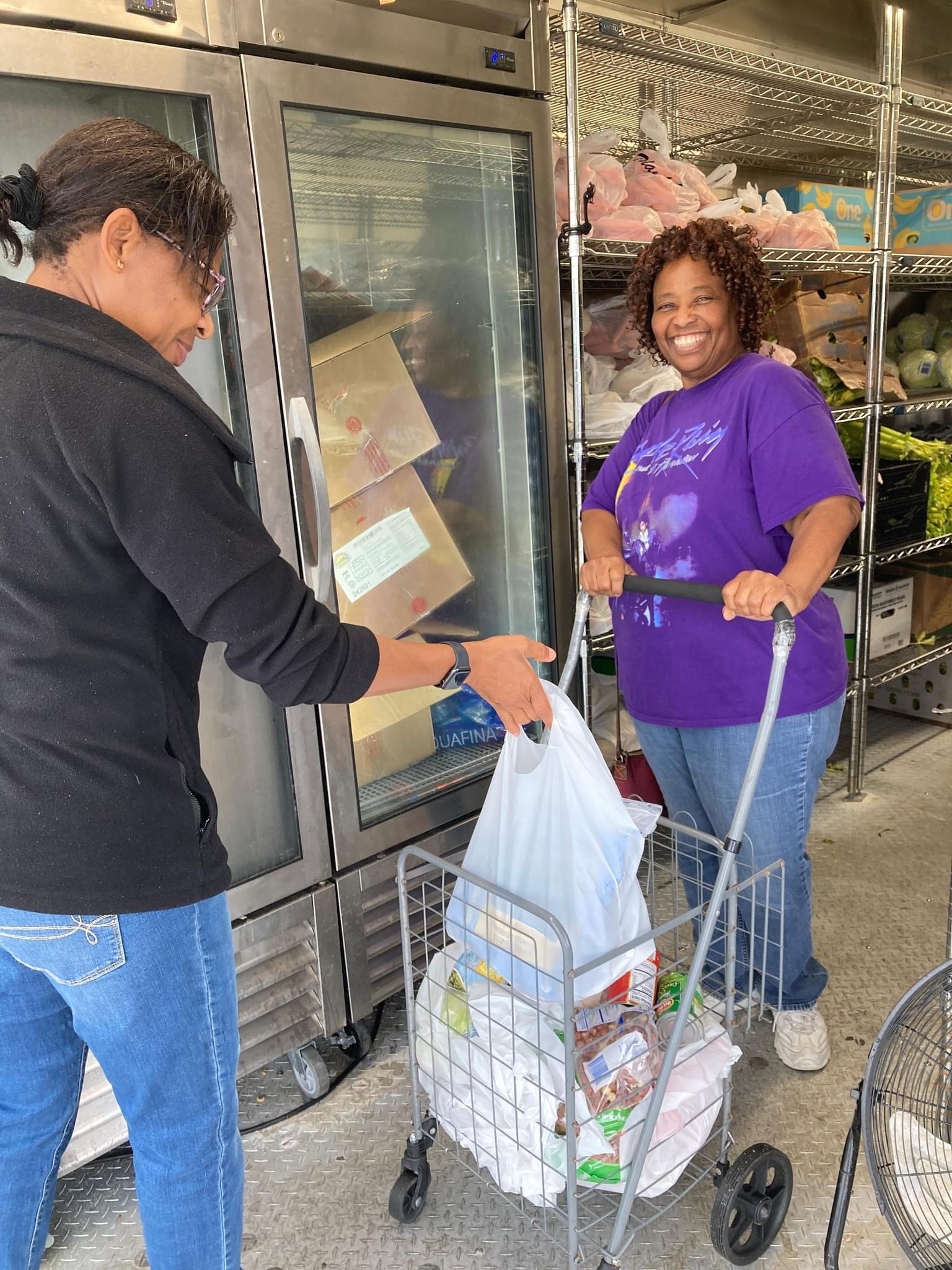
Share On Social!
Since the 1960s, community health centers (also called Federally Qualified Health Centers) have made it their mission to increase people’s access to primary healthcare by reducing barriers, such as cost, lack of insurance, distance, and language.
But beyond clinic walls, many people have big social needs, like unstable housing, that hurt their health.
That is why the National Association of Community Health Centers (NACHC) helped create a social determinants of health (SDoH) screening tool – PRAPARE® (Protocol for Responding to and Assessing Patient’s Assets, Risks and Experiences) – to enable community health centers to identify social needs among patients and refer them to local resources for aid.
Today, PRAPARE® helps hundreds of community health centers, like the HOPE Clinic in Houston, engage with and connect patients to food banks, housing resources, Wi-Fi, and more, with oversight from Nalani Tarrant, deputy director of social drivers of health at NACHC.
Let’s explore the importance of screening for SDoH needs; how NACHC led the development of PRAPARE®, a national standardized SDoH screening tool; and lessons learned from a community health center that has implemented a successful SDoH screening program with support from NACHC.
The Rise of SDoH Screening
30 million people of different racial/ethnic backgrounds, including Latinos, get primary healthcare at one of the 1,400 community health centers in the US.

Many of these patients are low income with public health insurance, such as Medicaid, or have no insurance. Given these circumstances, many of these patients also have social risk factors, such as low wages, unstable housing, unreliable transportation, and lack of healthy food options.
Social risk factors grow from the conditions in which we are born, grow, live, work, and age – also known as social determinants of health (SDoH). They can greatly help or harm our health and are at the root of health issues like obesity, diabetes, and certain cancers.
Fortunately, social needs are not predetermined and can be addressed, according to Tarrant.
“It’s interesting because a lot of folks say, ‘social determinants of health,’ but here at NACHC, we prefer the term social drivers of health,” she said. “To us, the word ‘determinant’ gives a sense of finality, stripping individuals of their agency to manage their own health and minimizing the accountability of those in power for the social and political decisions that create these inequities. Lack of access to nutritional food or affordable housing is not predetermined. Our country has a wealth of tools to address many social needs.”
Since their inception, community health centers have addressed patient needs inside and outside the doctor’s office.
NACHC’s desire to help community health centers improve population health outcomes and accelerate systemic change led to the development of the PRAPARE® SDoH screening tool and the National PRAPARE® Team, beginning in 2013.
SDoH screening is on the rise in healthcare systems across the US. The aim is to go beyond clinical care, which accounts for just 20% of patient health outcomes, and identify and address social needs. The effort uses a questionnaire to screen patients for social needs, who are then supported within the health practice or referred to community resources for help.
Furthermore, the COVID-19 pandemic and the role of structural racism and discrimination in poor health outcomes has brought SDoH issues to the forefront of health equity efforts.
“Recent events have galvanized health centers to stretch beyond meeting the needs of individual patients and to utilize powerful PRAPARE® data to change the systems that create poor health outcomes,” Tarrant said.
But implementing a truly effective SDoH screening program can be difficult; it requires a lot of planning, training, and collaboration among healthcare facilities and community organizations, such as food banks, transportation agencies, housing assistance programs, and more.
Creating the PRAPARE® SDoH Screening Tool
Crafting PRAPARE® was not an overnight success for the National PRAPARE® Team.

The screening tool required an iterative process that looked at existing protocols, national initiatives, and engaging with community health center staff that would use the tool.
“To create an effective tool, it was critical that we engaged with other healthcare organizations and importantly the frontline staff of community health centers who work with patients daily,” Tarrant said. “Then, based on our research and insights, the National PRAPARE® Team was able to identify SDoH domains that checked the criteria of actionability, sensitivity, and burden of data collection.”
Next, the National PRAPARE® Team led a one-year pilot test of the screening tool in community health centers across the nation to get a better sense of PRAPARE®’s strengths and weaknesses.
Health center staff that participated in the pilot recommended 16 SDoH domains for the core questions of PRAPARE®.
They also recommended including optional questions on incarceration history, domestic violence, safety, and refugee status in PRAPARE®. While these are important measures, they noted that health centers should decide whether to ask the questions based on staffing and resources available.

After the pilot, the National PRAPARE® Team standardized the tool and created an Implementation and Action Toolkit that officially launched in 2016.
“PRAPARE® has since become a gold standard for SDoH screening tools and remains the most dominant screening tool used amongst community health centers,” Tarrant said.
Today, PRAPARE® is available in over 25 different languages and has been implemented onto a plethora of digital platforms, including electronic health record systems.
The Implementation and Action Toolkit – available in English and Spanish – includes resources on how to implement PRAPARE®, how to use PRAPARE® data, and best practices and experiences/lessons learned from community health centers who piloted PRAPARE®, such as HOPE Clinic of Houston, Texas.
Implementing the PRAPARE® SDoH Screening Tool at HOPE Clinic
HOPE Clinic is one of many community health centers in the US that has implemented a SDoH screening program with the support of NACHC.
In 2016, HOPE Clinic piloted PRAPARE in one clinic, and other the next four years implemented PRAPARE to all five clinic locations.
The most common social needs seen in HOPE Clinic include lack of reliable transportation, food and housing insecurity, and unemployment.
However, implementing a successful SDoH screening program was no easy task. There were certainly some challenges that HOPE Clinic solved through trial and error and support from NACHC.
“This is not an overnight process because there’s a lot to consider,” said Dr. Andrea Caracostis, executive director and CEO of HOPE Clinic.
For example, connections with community resources are vital for building a reliable referral system when patients screen positive for social needs. Building this network can take some time, especially if a clinic has multiple locations.

Luckily, HOPE Clinic has been regularly working with almost 30 community organizations for the last 12 years.
“I think community health centers have been involved in the community since their inception,” Tarrant explained. “So, a lot of times they are already forming those relationships and partnerships with community organizations that they can refer patients to.”
Patient-provider trust is also critical. Without a trusted relationship with their provider, patients may not be willing to answer potentially sensitive screening questions.
That’s why Dr. Caracostis hires HOPE Clinic staff with her patients’ culture and language in mind.
“Our patients trust our nurses because they are from the community and know the language,” Dr. Caracostis said. “If you’re seeing a provider that looks like you and knows the same language, you’re able to form that trust a lot quicker. That’s why nurses initiate SDoH screening at HOPE Clinic.”
Dr. Caracostis also emphasized that not all patients may want to participate in screening. If a patient refuses SDoH screening, HOPE Clinic nurses respect that decision.
And sometimes, it’s not always appropriate to initiate screening questions.
“If a patient is really sick, then you probably don’t want to ask them if they’re hungry,” Dr. Caracostis explained. “Our nurses are really good about using their judgment to avoid overwhelming patients with questions when their real concern is the bumping headache they have.”
Other Considerations for SDoH Screening
Establishing SDoH screening seamlessly into the natural workflow is also key in helping patients and providers feel comfortable during the screening process.
After trial and error, HOPE Clinic determined that SDoH screening works best at the nurse’s station.
“Our nurses take the time to have an open conversation with patients,” Dr. Caracostis said. “Patients feel that they can share their story without assumptions being made about their health and social needs.”
If providers need additional support, NACHC steps in to help.
“A challenge we come across is that healthcare professionals may not feel comfortable asking these sensitive SDoH screening questions,” Tarrant said.
“So, my team at NACHC provides training to healthcare professionals, such as motivational interviewing techniques or empathic inquiry approaches, so that they can become comfortable and know how to navigate difficult or tough conversations. We emphasize that by understanding your patient social needs, they are better able to serve their community.”
“Another challenge that we hear from the field is, ‘I don’t have a resource for this patient, what do I do?’ We explain that even though you may not have a resource for them right now, discussing their social needs will help you to partner with the individual to create a care plan that fits their life. Having this information will also help the health center better understand what services to provide or what community-based organizations to connect with.”
Finally, closing the referral loop is another big feat of implementing a successful SDoH screening program.
Although HOPE Clinic refers all patients who screen positive for social needs to a community resource, “they may not get there,” Dr. Caracostis said.
Patients may not follow up with their referral for a variety of reasons, such as scheduling conflicts or lack of reliable transportation.
This is where a “closed loop referral system” – a standard process for tracking what happens to a patient after they are referred to a community resource – is so important.
“In regard to transportation issues, we’ve given patients bus tokens and gas money to help them follow up with their referral,” Dr. Caracostis said.
But ultimately, closing the referral loop at HOPE Clinic is still an ongoing effort.
“Most community health centers use an electronic health record system that keeps patient data all in one place to make tracking referrals easier, but how each clinic decides to tackle closing the referral loop is really up to them,” Tarrant said. “We always stress that community health centers know their communities best and know what is best for their patients.”
Success for the PRAPARE® SDoH Screening Tool
Addressing social needs is a powerful way to improve health outcomes in vulnerable patients, such as Latinos.
Tarrant recalls several “success stories” of PRAPARE®, but one stands out to her because of the immense generosity of a food bank and the power of SDoH screening data.

“When a community health center in Massachusetts was piloting PRAPARE®, they realized that food insecurity was a big problem in their community,” Tarrant explained.
“With the data they collected from SDoH screening using PRAPARE®, they were able to connect with the closest food bank in Boston, which was about 70 miles away. They explained that their community needed assistance with food, and because they had the data to show their community’s needs, the food bank agreed to drive 70 miles once a week to deliver fresh produce.”
Hope Clinic also makes a positive difference for food insecure families.
The clinic runs Bite of HOPE, a food program that focuses on bringing nutrition to food insecure neighborhoods and helping people of all ages, including children, learn more about nutrition to help prevent chronic disease later in later in life, such as obesity and diabetes.
PRAPARE® 2.0
Since PRAPARE® was launched in 2016, a lot has changed. The world has suffered through the global COVID-19 pandemic that further revealed long-standing health disparities and social needs, especially among Latinos and other communities of color.
That’s why Tarrant and the National PRAPARE® Team is working on PRAPARE® 2.0.
The updated screening tool will include new questions on topics such as digital and health literacy.
“Even in the US, some people don’t have Wi-Fi to access telehealth,” Tarrant said. “This came up a lot during the height of the pandemic. So, in PRAPARE® 2.0, we will ask questions like, “How much time do you have to access the internet? Are you comfortable using a smartphone or tablet to interact with your care team?”
PRAPARE® 2.0 is currently in the pilot phase. Based on findings and feedback, the National PRAPARE® Team is working with the PRAPARE® 2.0 Advisory Committee to determine next steps.
NACHC and the National PRAPARE® Team hope to launch the revised tool in 2024 with an updated Implementation and Action Toolkit. The revised PRAPARE® tool will also be translated into additional languages.
Lessons Learned for SDoH Screening
SDoH and social needs have always impacted health, and according to Tarrant, community health centers have always been working to address social needs in some capacity.
After all, they know their communities best.
Having PRAPRARE® further supports community health centers in their mission of achieving health equity, where everyone has a fair, just opportunity to be their healthiest.
While SDoH screening programs require collaboration among many parties, perhaps the greatest commitment must come from healthcare professionals for the program to be successful.
“SDoH screening should not just be another questionnaire for patients, right? It should be a life change. Providers must be committed and willing to take the extra time to address social needs that impact health,” Dr. Caracostis said.
Tarrant agreed.
“It’s really about making patients feel comfortable,” she said. “Providers should be hired from the community and learn to put aside their implicit bias. No matter their background, patients deserve to share their story free of judgement and receive quality healthcare and resources to improve their health.”
Explore More:
Health EquityBy The Numbers
1
out of 10
Pedestrians survive when hit by a car at 40 MPH
This success story was produced by Salud America! with support from the Robert Wood Johnson Foundation.
The stories are intended for educational and informative purposes. References to specific policymakers, individuals, schools, policies, or companies have been included solely to advance these purposes and do not constitute an endorsement, sponsorship, or recommendation. Stories are based on and told by real community members and are the opinions and views of the individuals whose stories are told. Organization and activities described were not supported by Salud America! or the Robert Wood Johnson Foundation and do not necessarily represent the views of Salud America! or the Robert Wood Johnson Foundation.



